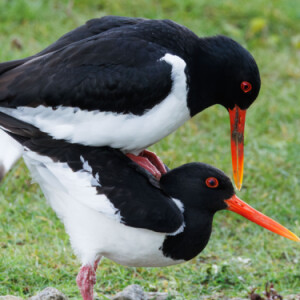Come hither
After handing the Boy Wonder back to his father in the car park at Slimbridge, I went in search of coffee and birds. The coffee, as per, was pretty grim, but the birds were good, even though I didn't manage to spot the famous White-spotted Bluethroat that's currently appearing at erratic intervals in a reed bed on the estuary.
I watched this female Oystercatcher march across a stretch of grass by one of the pools with an obvious sense of intention, before issuing this clear invitation to the male. As you can see in the second photo, he didn't have to be asked twice.
Though many are resident here, Oystercatchers tend to be quite mobile birds. We're reckoned to have 100,000 breeding pairs in the UK, but in the winter, when birds tend to congregate around the coast and the mudflats of major estuaries, that number is doubled by migrants from Iceland, Scandinavia and Russia. In turn though, some of our juvenile population moves south to winter in southern Europe. Breeding adults return to their nest sites between March and May; some of these are coastal, but due to nest disturbance at coastal sites an increasing number of birds nest inland, on river banks and around the edges of lakes and flooded gravel pits. At the coast they mainly feed on shellfish, but inland they primarily eat worms - in fact, the first Oystercatcher I saw this year was worming along the grass strips of the Slimbridge overflow car park.


Comments
Sign in or get an account to comment.


